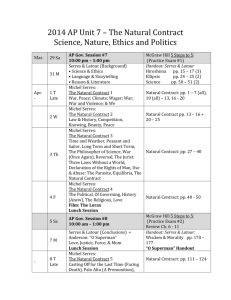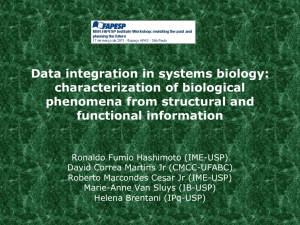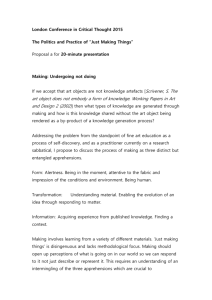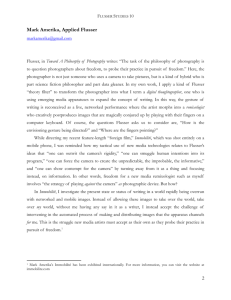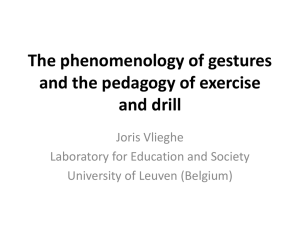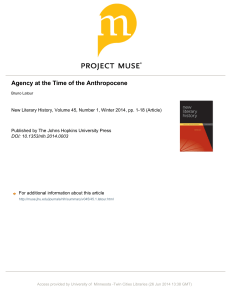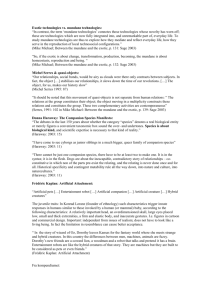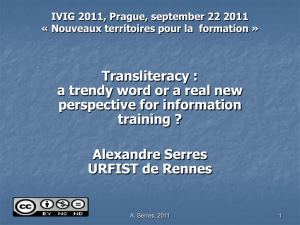Document 10464799
advertisement
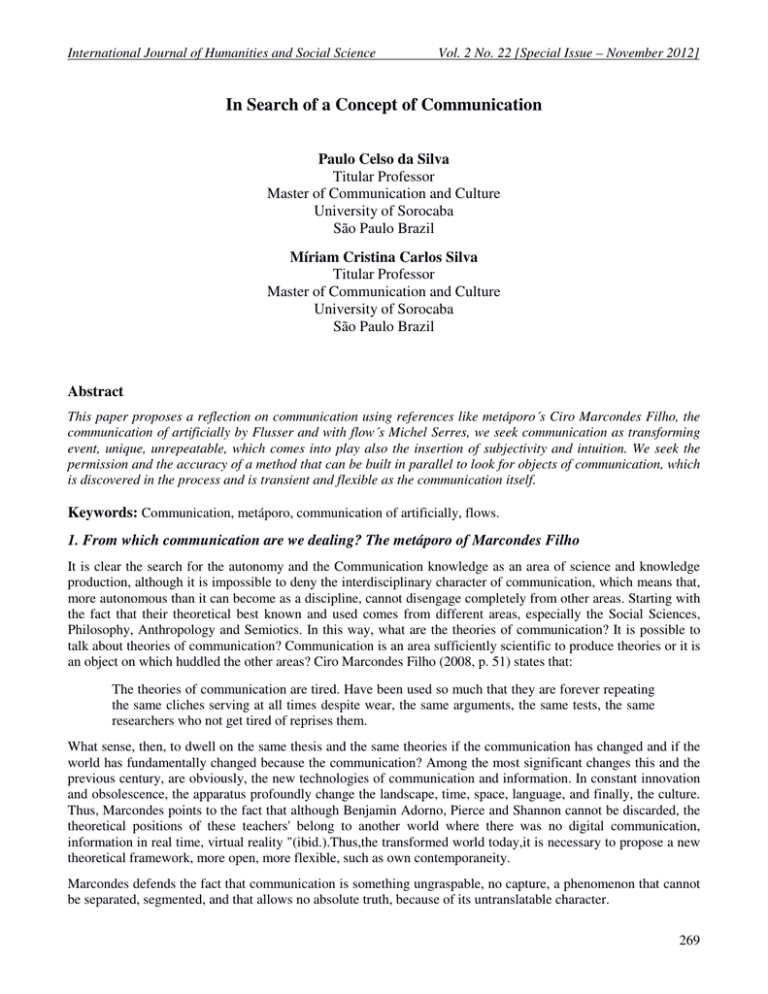
International Journal of Humanities and Social Science Vol. 2 No. 22 [Special Issue – November 2012] In Search of a Concept of Communication Paulo Celso da Silva Titular Professor Master of Communication and Culture University of Sorocaba São Paulo Brazil Míriam Cristina Carlos Silva Titular Professor Master of Communication and Culture University of Sorocaba São Paulo Brazil Abstract This paper proposes a reflection on communication using references like metáporo´s Ciro Marcondes Filho, the communication of artificially by Flusser and with flow´s Michel Serres, we seek communication as transforming event, unique, unrepeatable, which comes into play also the insertion of subjectivity and intuition. We seek the permission and the accuracy of a method that can be built in parallel to look for objects of communication, which is discovered in the process and is transient and flexible as the communication itself. Keywords: Communication, metáporo, communication of artificially, flows. 1. From which communication are we dealing? The metáporo of Marcondes Filho It is clear the search for the autonomy and the Communication knowledge as an area of science and knowledge production, although it is impossible to deny the interdisciplinary character of communication, which means that, more autonomous than it can become as a discipline, cannot disengage completely from other areas. Starting with the fact that their theoretical best known and used comes from different areas, especially the Social Sciences, Philosophy, Anthropology and Semiotics. In this way, what are the theories of communication? It is possible to talk about theories of communication? Communication is an area sufficiently scientific to produce theories or it is an object on which huddled the other areas? Ciro Marcondes Filho (2008, p. 51) states that: The theories of communication are tired. Have been used so much that they are forever repeating the same cliches serving at all times despite wear, the same arguments, the same tests, the same researchers who not get tired of reprises them. What sense, then, to dwell on the same thesis and the same theories if the communication has changed and if the world has fundamentally changed because the communication? Among the most significant changes this and the previous century, are obviously, the new technologies of communication and information. In constant innovation and obsolescence, the apparatus profoundly change the landscape, time, space, language, and finally, the culture. Thus, Marcondes points to the fact that although Benjamin Adorno, Pierce and Shannon cannot be discarded, the theoretical positions of these teachers' belong to another world where there was no digital communication, information in real time, virtual reality "(ibid.).Thus,the transformed world today,it is necessary to propose a new theoretical framework, more open, more flexible, such as own contemporaneity. Marcondes defends the fact that communication is something ungraspable, no capture, a phenomenon that cannot be separated, segmented, and that allows no absolute truth, because of its untranslatable character. 269 The Special Issue on Social Science Research © Centre for Promoting Ideas, USA www.ijhssnet.com From this premise, the conclusion could be reached about the futility of communicative studies invalidate the fact that communication itself as investigative area and production of knowledge. However, an exit to understand the communication referred to the author is the perception, that, although intangible, it "touches us, surrounds us, makes us change position" (ibid, p. 52). Marcondes complements saying: It is a social process, an event, a combination of multiple vectors (social, historical, subjective, temporal, cultural) that is given by the friction of bodies and expressions, something that occurs in an atmosphere, allowing to carry out, from its, something new among the participants of the communicative act, something that did not have before and amending its previous status. To Marcondes (ibid.) this is a trait of relevance of communication. To alter the things, change them, not to allow remaining as before. Thus: no one leaves unscathed after a truly communicative act. If you get away is because communication failed to materialize, got stuck in the rituals, the formalism, the endless repetition of the same (Sfez), the continuous motion of no-place, dead in the flow of their movement recursive. So effective communication is very specific and different. It is not novel whose ending is very predictable, attached to formulas that are repeated with a few modifications that fail to cause any shock. We could not call the newscast communication presented by a rigid gestures, from a facial simulation of seriousness impartially narrated, nor can we call communication said good morning and answered automatically, so cold, that does not change neither the day nor those who wanted (wanted?) good and not those who answered (answer?). The communication, therefore, would be far from the rituals that aim to simulate or even, the formality contained in social interactions, in the grammars. Marcondes (ibid,p. 53) explains that it is outside the large social media that convey communicative signs. According to the author, it is necessary to assure that the "communication event" (ibid.) and for an event is necessary to go beyond the signs for a deeper dive, seized the meanings beyond the obvious and unexpected The communication that Marcondes tells us, is "beyond language, beyond the sign, beyond meaning, building senses unpredictable, unique, unrepeatable, and unexpected" (ibidem).From this reasoning it seems justifiable to say that art can be an effective means of communication, even so the only communication possible, for this character to go beyond language, beyond meaning. It is about a language based on the unpredictability, the uniqueness, and the unexpected. This is an event focused on the experience and that leads to one becoming involved not rule out the subjectivity of the experience itself, by contrast, features it. Although we exchanged messages every day, with the evident purpose of communicating, for Marcondes this relational communication "does not interfere with anything, does not cross the membrane that isolates each of us from the surrounding world" (ibid, p 54). Communicate, in some way, to deceive us. To forget our deep solitary confinement and isolation. But there is another level of communication, according to the author, less guarded and ostentatious and second processes, even unconscious, "that the membrane is crossed and the certainties are turned installed, creating change. There was effective communication "(ibidem.). Once more, it seems that we, in this case, we find in the area (not only, but especially) art, shifting territory, able to shake the existential certainties and language (as our consciousness is linguistics, according to Bakhtin), able to restructure our view, offering us a chance not only to represent the world around us, but proposing a new model of the world, invented, and can be used to reconstruct the "real" world around us. In "The andaluz dog”, Buñuel suggests, through the eye at close longitudinally cut by a razor, an epistemological a new way of seeing things (Coelho Netto). Certainly there are other areas able to propose the same, but the art can promote this cutting, which we wish to draw effective communication. So even sustained by Marcondes to propose a method for studying the communication, which will include the communicative dimension as a transformative event, unrepeatable and unique? The author explains that we must work with the study of communicative event, in other words: "the event results from the bodies of their mixtures, but it is different from that: it is his attribute intangible" (idem, p. 55). After the event, others are never the same. And this is immeasurable intangible, impalpable, different for each one of the experiments. To do so, investigate the incorporeal result of communicative experience, rather than a method, explicitly Marcondes, it is an "almost" method: 270 International Journal of Humanities and Social Science Vol. 2 No. 22 [Special Issue – November 2012] that purports to capture the transient, to accept the challenge of understanding what is not to consolidate, to relocate the question of Heraclitus: "How to search for anything you do not know?" This can only be achieved through commitment to a nomadic science. By treating communication as a nomadic science, Marcondes (idem, p. 57), supported by Vilém Flusser explains that makes nomadic thought like that: People who believe in the wind and not in the soil, going behind something, no matter the goal pursued, the search never ends, even when it is reached. For the nomad thought, all goals are intermediate stations, and they are together in the way, as a whole, walking is a method without a goal. For this reason the proposal of Marcondes for a new communication theory refutes the term method in view of "the rigor of a particular walk, consolidated, hard research, that does not give space to the appearance of unpredictability" (idem, p. 59). The author proposes the metáporo (meta + pores): Since Sarah Kofman and his concept of pore, is road breaking itself, as a vessel that opens its own route as follows- the style of Freud talking about dreams - and that is different from officers of a odos, this is opening a passage through a chaotic extension, a pore by introducing different ways, making possible new directions in space. To Marcondes (p. 59) it is, therefore, a route to be built in the research process, far from a closed course, delimited, but: An entangled pulsating and alive, moments, fluxes, vectors, and crossing orbits. And, inside this large map, what matters is to research the interstices, the contact surfaces, the points of transmission, or, that which performs the function of the medium. Art, as polysemic language, focusing on the experience, affirms, may therefore be a metáporo to understand the incorporeal communication. Putting the art in dialogue and communication is the option of a nomad thought, shifting, attentive to the lines, the gaps, to the possible and not probable to. It is the communication that interests us, liberating and temporary. It seems that much of this incorporeal communication of the event, pointed out by Marcondes, also involves the concept of Flusser ´communication. 2. Communication to Flusser - communication, culture and art (and) ifícios For Flusser Villém human communication is an artificial process. It is about a phenomenon consisting of artifices, discoveries, tools, instruments. Symbols are organized into codes that seek to make a man forget, albeit temporarily, of its inescapable condition of being mortal. The author explains that "men communicate with each other from unnaturally way" (2007, p. 89). We can add to the reasoning of Flusser that, talking for example, which seems to be ours by nature, it is a product of learning, and it is different from culture to culture, as well as writing and gestures. Shake his head in agreement or frowning are not gestures of strangeness natural, instinctive, though apparently unconscious. In another sphere of complexity, it is not natural to make poetry, cinema, theater, and dance. All these languages are human artifacts, very different from the dance when the bees find honey. The same way as communication is not natural, Communication Theory also it is not a natural discipline, explanatory. For Flusser, this unnatural condition is what defines the man as a political person their relationships are not natural and even the most primitive, such as breastfeeding and sex ,they are artificial action, marked by the culture. . There is no doubt that culture prints a different look on the mother for the child who is breastfed, a way to behave during lactation, public and different conditions of offering the breast when feeding, even within a deeroticized, but that can become perpetrator, aggressive and censored. Just recall the episode when the mother who nursed her son in a Cultural Institute of São Paulo (2011) was asked to leave the room because the place was unsuitable for the act, in an assessment of the security. . 271 The Special Issue on Social Science Research © Centre for Promoting Ideas, USA www.ijhssnet.com Established the controversy and the media aware of the fact it was claimed that the interpretation of security to be correlated with the prohibition of "feed" that place, curiously a spot of culture and art. The officers apologized to mothers who, outraged, organized a "protest" in front of the institute. To remedy the situation the leaders told that would guide the best employees, and that all moms were welcome, with or without their young hanging to the teats. But the fact is, there are tons of similar stories around the world, mother to breastfeed kicked out of pub in London, other arrested, other angry because the colleagues did not deign to cover her breasts while breastfeeding. Anyway, this is a natural act of deep communication between mother and child, however, it is also an unnatural act, deeply marked by the culture and the intertexts of eroticism, sanctions, collective misunderstanding. Sex, primitive need for the preservation of species, is characterized by the culture, ritual, erotic, diverted from its reproductive function for the ludic and it is certainly one of the most confusing interference in the act of breastfeeding, contaminated of fault by the desire and the look from the other. Flusser affirm, however, that not always the artificial character of the communication is conscious: "After learning a code, we tend to forget its artificiality" (ibid, p.90). Is thus a false naturalization what comes artificial. The codes, explains Flusser, become a second nature. The artificial world's from second nature makes us forget the world's first nature. The communication device of the encourages delude ourselves about our condition of being mortal and the lonely.Thus, the primary objective of the communication would be, especially: make us forget insignificant in this context that we are - all alone and "incommunicado" - that is, to make us forget in this world that we occupy a solitary confinement and that we are condemned to death - the world of nature (ibid., p. 90). Human communication is therefore "an artifice that is intended to make us forget the sheer senselessness of a life condemned to death" (ibid., p. 90). From this essential goal of communication, to make us forget our essential nature, of mortal beings, Flusser explains the man condition as a political animal. The author explains this human condition, "not because it is a social animal, but because it is a solitary animal, unable to live alone" (ibid., p. 91). The communication, we can say is, therefore, adding to the thought of Flusser and Marcondes, the search for communicative event, that is, the intangible result of a transformation, the effective communication, a lapse that eludes us of our condition of mortal beings and lonely. The Communication Theory by Flusser is classified as an interpretative discipline, since it needs to create meaning, to interpret the phenomena much more than explain them. And the author adds this reasoning considering that one thing becomes nature to the extent that is explained or becomes spirit in that one decides to interpret it. In this case, the difference between natural science and science of the spirit (or humanities) is defined by the positioning of the researcher. . The same phenomenon was analyzed under different aspects, it becomes a different phenomenon. The cloud explained is not related to the cloud construed, is not the same object, clouds become different from one another in accordance with the point of view. Flusser points to communication as an interpretative discipline, or, a significant phenomenon to be interpreted. The communication explained, therefore, is different from the communication interpreted. They are different phenomena. Interpreting is an open communication to understand the communication – a metáporo, is more than one method, again adding to Flusser and Marcondes. Flusser ponders about human communication as unnatural, contranatural, when proposing to store acquired information, which makes negative entropy, since then, while it tends to disorganization, human communication proposes an organization of information and adds that is a fundamental characteristic of man, an animal that found tricks to accumulate acquired information. This accumulation of information is a process, more than necessity of freedom, according to the theory. Communicate is, therefore, in the Flusser´s view, an attempt to give meaning to the meaninglessness of a life haunted by death. Human communication is therefore a phenomenon of freedom, whose main purpose is to deceive. It is an illusion that serves to make life livable. We live then in a codified world, built from ordered symbols, and it is repressed the acquired information. Flusser describes two basic forms of communication that are not mutually exclusive, they are interdependent, but they are distinct in several respects. He explains that to produce information, the men exchange different information available in the hope of synthesizing new information - the communication is dialogic. 272 International Journal of Humanities and Social Science Vol. 2 No. 22 [Special Issue – November 2012] In the second form described by Flusser, the existing information is shared so they can resist the effect of entropic nature - the discursive communication. On the relationship between these two forms, Flusser explains that the discourse cannot live without dialogue for to have a dialogue it must have been before the apprehension of speeches. To have a speech transmitter must have the information produced in the previous dialog. The difficulty, however, argues the author, is the production of effective dialogue. There is a pervasiveness of dominant discourses, which makes dialogue impossible and unnecessary. Again, the thought of Flusser and Marcondes seem to run in parallel: what remains to the man is incommunicado. Contrary to appearances, not all is effective communication. The communication, according to Flusser only reaches its goal when there was a balance between discourse and dialogue. When there is a predominance of speeches, which occurs, according to the theory, it is lonely among men, despite the constant contact with sources of information. When, on the other hand, there is a predominance of provincial dialogues, the same loneliness looms those men who feel cut off from history. And,reinforcing our proposal, a momentary change of reference, and then, go back to the text: The intellectual sciences, being natural to man, as being endowed with reflection, especially not belong to one nation: it appears that all civilized people gave themselves up to his study and know about each other so well, what its principles and what issues dealing. These sciences have existed for humanity since there was civilization in the world IBN KHALDUN(1332 -1406) 3. Michel Serres, the 5 senses, Hermes, angels and communication In many works by Michel Serres, the theme of communication is handled unconventional. Attending to one of his works, "The Legend of Angels," 1993, which should be classified as a test of communication - and not as a theological study or angelology - and about the current problems of the technological society that has,in the concept communication center of his philosophical reflections. Thus we have in front of us a first important concept, the Message, or, those messages that pass through walls, like the messages that follow by email, cell phones and other technical devices that make this moment of communication, however, as seen before, reduce the concept of communication only to established canons. Serres, doesn´t. The French became of the philosophy that "Is not a knowing, or a discipline among the sciences usual, because it sticks closely to this ratio between the whole and nothing " (1999: p.121). Understanding, this whole, the encyclopedic, and nothing, the ignorance, not open to the thought, doubt, uncertainty, error, lateral thinking. Faced with this positioning, Serres harshly criticizes the repetition, so always insist that the invention [conceptual] is certainly better than rigorous because the former can be misleading, however, the second takes to immobility (1999, p 172). So, against some usual currents, argues that intellectual honesty consists in writing what one thinks and believes that as an author: A word about this last word that comes from Roman law and means: a guarantee of authenticity, fairness, a statement from a witness or oath. But originally, it means that increasing, not one who takes, summarizes or decreases, but only one that makes grow. Author, enhancer ... all else is mistake. The project evolves in growth, like a tree or animal. (SERRES, 1999: p. 110) All of this indicates that Serres does not work with fixed, rigid, solid, but unlike with the flow, the flexible, soft in his philosophical making, the communication understood by him and reflected by it, following this path through the Messagens, the five senses in the communication society [said] communication. Just illustrating another contemporary philosopher, Norbert Bilbeny will say that without the senses do not have the possibility ethics in the digital age (1999). 273 The Special Issue on Social Science Research © Centre for Promoting Ideas, USA www.ijhssnet.com But, returning to Serres, The great contribution of Michel Serres, in our view, the construction of a New Theory of Communication, as well as a path to the investigation of communication, is in his epistemology, which, he says, is "less solid" and more fluid flows in the betting, always in search of the elusive and fleeting. Traditionally when it was thought in terms of the solid, the resistant, hard, crystalline.Science has not done anything else than be based on what was stable (our parmenidiana heritage, we should say). It is time to reverse and start looking at what is living, changing, in transformation. (MARCONDES FILHO, 2008) To achieve his purpose, Serres search Greco Roman atomist philosophy in which rescues the concept of clinamen (declination) which Epicurus called the spontaneous movement of the atoms that led to the diversion out of line drop caused by its weight, "this spontaneous movement does not imply a conscious deliberation is a kind of freedom mechanical" (Brun, 1987: p.66 .) Also Lucretius and later Leibniz 'philosophy of the first author of the communication, says Serres, the communication of substances, not relations "(MARCONDES FILHO, 2008) developed their philosophies based clinanem, without being taken seriously by" science "given the difficulty of proving that movement. Serres however, depending on the search for new, walk these steps demonstrating how deviance is important and creator, as "the deviation, strictly, is the principle of life ... if there is a world it is because they are divergent with respect to zero "(MARCONDES FILHO, 2008). In the work Mestizo Philosophy, Serres was already developing the idea of a third that goes beyond the synthesis of one another, this or that language, that purity that a philosophy - and by extension a theory of communication - wait, the third is like the pied the result of its multiple skins, travels the universe marked in his body it´s impossible to strip (SERRES, 1993: p.1-6). So do philosophy and communication is to use the five senses, and not just the language, is to make the whole body showing that there is more thinks in the world than we can say of them, the world is more than language. Here his proposal for a theory of communication already delineates: a communication theory of bodies where He is the first holder of memory and transmission, nothing in the agreement fails to pass before the senses, it was our first cogito. I feel, see, savor, hear, smell, touch, says Serres, and then I speak. But it is a hollow body, porous, perforated, the style of full body without organs (MARCONDES FILHO, 2008). We are facing to clinanen described before, the empty and full of movement, the decline, in some form of chaos necessary, since nature seeks the simple and necessary, then the happiness and breaks the linear mechanics of atoms, creating the new , then freedom for man, as Epicurus said. That being so, the communication occurs, happens at all times of the world, the world is the space of communication. However, communication in this world is in the hands of a few powerful and thus the path is to abolish this "middleman" and talk directly with each other, without intermediaries, in a direct transmission, the models that young people mark when its manifestations without the support of political parties or social institutions. An interesting image is described by Marcondes Filho (2008) The communication is to produce the third as from the confluence of two ... a third between the first and second person, circulating among his relations. And in fact only starts when people lower their guard: the dialogue, in reality, says Serres, is practiced by four people: two spoken, the third excluded, which is the devil of them, plus third included, their hope, a god who is born in their midst. The communication is as direct contact between people, and among people and the world. Since then, Marcondes Filho (2008) proposes a new method for communication that "exceeds" those mentioned previous: the exodus and the rodeo method. 274 International Journal of Humanities and Social Science Vol. 2 No. 22 [Special Issue – November 2012] The exodus is the beginning, it is the lost. It's starting to teach, as the very essence of pedagogy, "in fact, without having learned nothing left or taught anyone without inviting him to leave the nest" (SERRES, 1993: p.14). Wandering, choose the fork and go down the road toward the place ignored. From this meeting we have mestizo man, mestizo place now. At the moment in which is divided, everything begins. The communication with the other and the world also includes the loneliness of being in the middle between two sides after a match. Neither there or here. The previous references that melt and make then foreign. But this foreign body learned other relations, already makes a new body and not just a body that has moved. The exodus as a method gives rise to the seduction, that is, driving to another place. The search for different route is less obvious, less easy to ensure that communication in their manuals and templates. On this route, is still searching for the sensitivity, "a word that means the ability or capacity in every way," says the Serres. Another moment but the same methodology is the rodeo which also means to monitor, engage. As Serres reminds us, to create you need to know everything and have to has worked hard. However, a complicating factor: the science, criticism, teaching traditional sterilized because they deal only analyze and judge, "that is the proper way the powerless, who together enjoy all the powers" (1991: p. 114). The rodeo thought, that wanders, goes through spaces, empty and vortices, if you want to create must enter the whole body, feelings touched the skin, solitude and abandonment of the easy and convenient, freedom, pleasure, anger, passion and strength. So many feelings and states resisting against “ many works already made as the institutions which are parasites" (ditto, ditto). 4. Seeking communication flows, angels, new senses over the five Which communication that we mean, then? The communication in this palimpsest, built on an interim basis on parchment which is continuously rewritten. From the original texts, remaining pieces that complement the new ideas and build intertexts, which are valid in the hazards and gaps to be, filled again, the subtext, the unpredictable With Marcondes Filho, Flusser, Serres, seek the communication as transforming event, unique, unrepeatable, which comes into play also the insertion of subjectivity and intuition. We seek the permission and accuracy of a method that can be built in parallel with the look for the objects of communication, which is discovered in the process and is transient and flexible as the communication itself. What is expected is to understand how the devices are built to make us forget our condition of human beings hopelessly lonely and deadly. Communication as organizing effort of chaos. The own theory of communication as interpretive science that seeks to make sense of what makes no sense, rather than explain will not have the same explanation. A participatory method, more than investigative, in which it invests whole body, with all the senses and the possibility of experience, knowing that communication is the essence of life itself, and "life is not only what you see, is a little more, "as they said will Paulinho da Viola and Herminio Bello de Carvalho. 275 The Special Issue on Social Science Research © Centre for Promoting Ideas, USA www.ijhssnet.com 5. Referências BILBENY, N. (1997). La revolución em la ética. Hábitos y creencias em la sociedad digital. Barcelona: Anagrama. BRUN, J. (1987).O Epicurismo. Lisboa:Edições 70. FLUSSER, V. (2007) O mundo Codificado. Por uma filosofia do Design e da Comunicação. São Paulo: Cosac Naify. KHALDUN, I. (1960). Os prolegômenos ou Filosofia Social. Tomo terceiro. São Paulo: Editora Comercial Safady Ltda., tradução integral e direta do árabe de José Khoury e Angelina Bierrenbach Khoury MARCONDES FILHO, C. (2008). Comunicação, uma ciência anexata e contudo rigorosa IN Comunicação – novo objeto, novas teorias? Teresina:EDUFPI. MARCONDES FILHO, C. (2008). Michel Serres e Os Cinco Sentidos da Comunicação. Revista Novos olhares, 6 Novembro de 2008, Disponível em: http://revistanovosolhares.wordpress.com/2008/11/06/michel-serres-e-os-cinco-sentidos-da-comunicacao-de-ciromarcondes-filho/ . Aceso em 28.08.2011. SERRES, M. (1990). Hermes. Uma filosofia das ciências.Rio de Janeiro:Graal, 1990. In English : Hermes: Literature, Science, Philosophy . The Johns Hopkins University Press (August 1, 1983) SERRES, M. (1993). Filosofia Mestiça. Le tiers.Instruit. Rio de Janeiro:Nova Fronteira. In English: The Troubadour of Knowledge (Studies in Literature and Science) . University of Michigan Press (December 15, 1997) SERRES, M. (1993). A lenda dos Anjos. São Paulo:Aleph. In English : Angels, a modern myth. Flammarion/USA, University of Michigan Press 1995. SERRES, M. (1999). Luzes. Cinco entrevistas com Bruno Latour. São Paulo: UNIMARCO editora. In English: Conversations on Science, Culture, and Time: Michel Serres with Bruno Latour (Studies in Literature and Science). University of Michigan Press (May 15, 1995) SERRES, M. (2001). Os cinco sentidos. Filosofia dos corpos misturados. Rio de Janeiro: Bertrand. In English:: The Five Senses: A Philosophy of Mingled Bodies (Athlone Contemporary European Thinkers). New York, Continuum; 1 edition (February 11, 2009). 276

